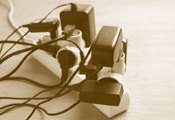Whether you are working in an office setting, at a construction site or even in a restaurant, there are a number of electrical hazards to be aware of. Taking a proactive approach to using appliances and equipment, extension cords and outlets can help create a safer workplace for you and your coworkers.
Developing a workplace safety program that includes a strong electrical safety component can help create a more aware team of employees.
Circuit Protection
-
Overloading electrical circuits is extremely dangerous and should not be permitted.
-
Computer networks, lighting and security systems should be installed as recommended by the manufacturer and in accordance with the National Electrical Code.
-
Breaker boxes should be accessible at all times and not covered by equipment, cabinets or shelves.
Extension Cords
-
Extension cords should be capable of handling the load without overheating.
-
Do not use multiple plug attachments on extension cords.
-
Extension cords should be free of exposed wiring and splices, and cracked casing.
-
Extension cords must only be used for temporary purposes, not for permanent installation.
-
Do not run extension cords under rugs, carpets or chair mats. They should not be placed where they could be damaged by foot or vehicular traffic.
Inspection and Testing
-
All electrical equipment should have a label of a nationally recognized testing laboratory such as the Underwriter's Laboratory (UL) or the Factory Mutual Engineering Corp (FM).
-
Conduct monthly inspections of equipment to ensure all electrical cords are in working order.
-
Any electrical equipment that is damaged, malfunctioning or showing signs of heating or shocking should be replaced immediately.
-
Electrical wall outlets should be free of cracks or breaks. Any damage must be repaired.
-
Avoid excess bending, stretching and kinking of electrical cords. Do not jerk cords out of the wall, and never staple, nail or tack them.
For more information on workplace electrical safety…
Occupational Safety & Health Administration: www.osha.gov/SLTC/electrical
Centers for Disease Control and Prevention: www.cdc.gov/niosh/topics/electrical/






